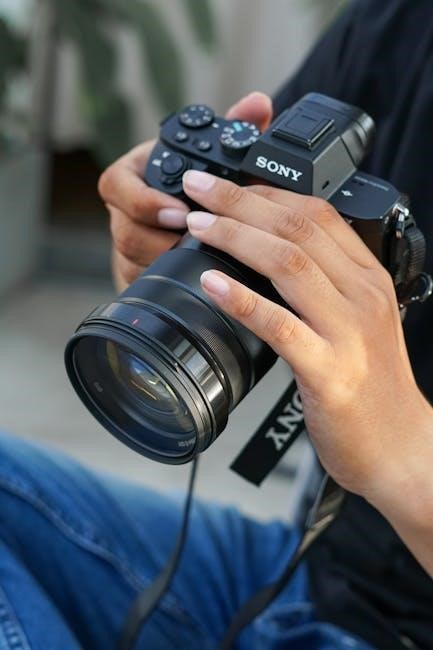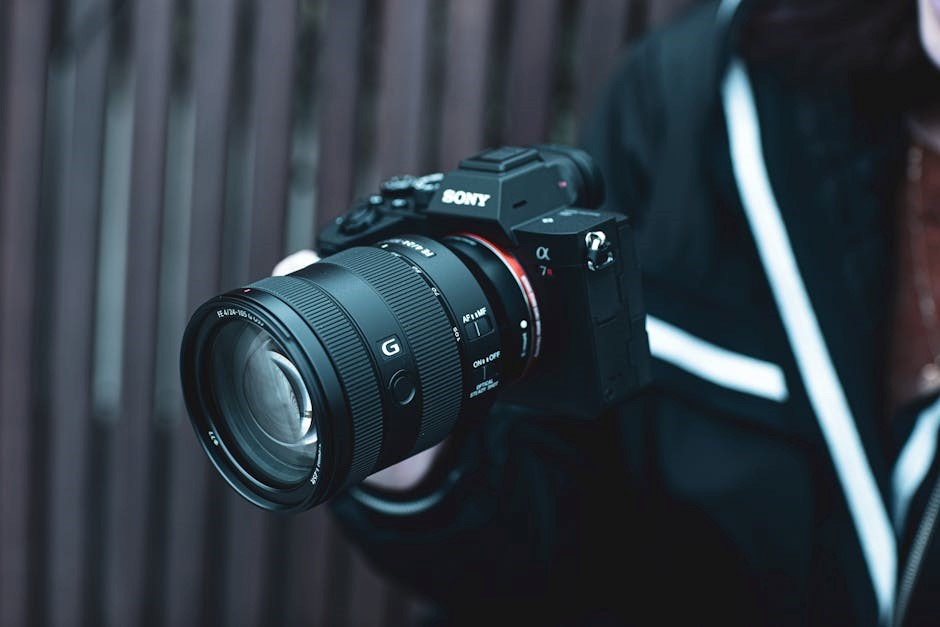Sony A80J Manual: A Comprehensive Guide
This guide provides a detailed overview of the Sony A80J OLED TV manual, offering assistance with setup, features, and troubleshooting. The manual acts as a resource for understanding the TV’s capabilities, ensuring users optimize their viewing experience, and addressing common operational issues.
The Sony A80J series represents a leap in home entertainment, combining OLED technology with intelligent processing for a stunning visual experience; As part of Sony’s BRAVIA XR lineup, the A80J boasts the Cognitive Processor XR, which enhances picture and sound in real-time, mimicking how humans see and hear. This series offers vibrant colors, deep blacks, and exceptional contrast, bringing movies, shows, and games to life with remarkable clarity. The A80J operates on the Google TV platform, providing seamless access to a vast library of streaming apps, content, and smart features. Users can easily navigate through personalized recommendations, control smart home devices, and enjoy voice search capabilities with Google Assistant.
Available in various sizes, the A80J caters to different room sizes and viewing preferences. Each model features Acoustic Surface Audio, where the screen vibrates to produce sound, creating a more immersive and realistic audio experience. Gamers will appreciate the HDMI 2.1 compatibility, enabling features like 4K/120Hz and Variable Refresh Rate (VRR) for smooth and responsive gameplay. The A80J series is designed to deliver an unparalleled home entertainment experience, blending cutting-edge technology with user-friendly features.
Accessing the On-Screen Help Guide
The Sony A80J series features an integrated on-screen Help Guide designed to provide immediate assistance and answers to frequently asked questions. Accessing this guide is straightforward, allowing users to quickly resolve issues or learn about specific features without needing to consult external resources. To open the Help Guide, simply press the “HELP” button located on the remote control. This action will launch the Help Guide interface directly on your TV screen.

The Help Guide is organized into various categories, covering topics such as settings, functions, internet connection, and troubleshooting. Navigating through the guide is intuitive, allowing you to browse relevant sections or use the search function to find specific information. The on-screen manual provides step-by-step instructions, clear explanations, and helpful tips to optimize your TV experience. It also includes visual aids and diagrams to further clarify complex settings or procedures. Whether you’re setting up your TV for the first time or encountering a technical issue, the on-screen Help Guide is a valuable resource for quickly finding the information you need.
Understanding the Reference Manual
The Sony A80J Reference Manual is a comprehensive document providing detailed information about your TV’s features, functions, and specifications. Unlike the on-screen Help Guide, which offers quick solutions and basic instructions, the Reference Manual delves deeper into the technical aspects of the A80J, offering a more thorough understanding of its capabilities. This manual serves as an essential resource for users seeking in-depth knowledge of their TV and its advanced settings.
The Reference Manual covers a wide range of topics, including detailed explanations of picture and sound settings, connectivity options, troubleshooting tips, and product specifications. It often includes diagrams, charts, and technical illustrations to enhance comprehension. While the Help Guide is ideal for resolving common issues, the Reference Manual is invaluable for users who want to fine-tune their viewing experience or understand the underlying technology of their A80J. It is typically available as a PDF download from the Sony support website, allowing for easy access and offline viewing. Familiarizing yourself with the Reference Manual can empower you to unlock the full potential of your Sony A80J.
Navigating the Settings Menu
Effectively navigating the settings menu on your Sony A80J is key to customizing your viewing experience; The menu is organized into several categories, including Picture, Sound, Display & Sound, Channels & Inputs, Network & Internet, Accounts & Sign-in, Apps, Device Preferences, and Remotes & Accessories. Each category contains a range of options that allow you to adjust various aspects of your TV’s performance.
To access the settings menu, press the “Quick Settings” button (often represented by a gear icon) on your remote, then select “Settings.” Within the Picture settings, you can fine-tune parameters like brightness, contrast, color, and sharpness. The Sound settings allow you to adjust volume, sound mode, and audio outputs. Display & Sound offers options related to screen resolution, HDR settings, and HDMI settings. The Network & Internet section enables you to connect to Wi-Fi, configure network settings, and perform network diagnostics. Device Preferences provides access to system settings, date & time, accessibility options, and more. Experimenting with these settings will allow you to optimize your A80J to suit your individual preferences.
Troubleshooting Common Issues

Encountering issues with your Sony A80J is inevitable, but often easily resolved with basic troubleshooting. A common problem is a lack of picture or sound, which can stem from incorrect input selection, loose cable connections, or a muted volume. Ensure the correct input source is selected and all cables are securely connected. Try power cycling the TV by unplugging it for a few minutes, then plugging it back in.
Another frequent issue involves network connectivity. If you’re experiencing problems connecting to Wi-Fi, verify your network password and ensure your router is functioning correctly. If apps are crashing or freezing, clearing the app’s cache and data or reinstalling it can often resolve the problem. Picture quality issues, such as excessive redness or improper calibration, can be addressed by adjusting picture settings. If these steps fail, consulting the A80J’s on-screen help guide or the downloadable PDF manual will provide more specific troubleshooting steps. For persistent issues, contacting Sony support is recommended.
USB File Playback Problems
Users sometimes face issues when playing media files via USB on the Sony A80J. A common complaint is the TV not recognizing the USB drive or specific file formats. Ensure your USB drive is formatted in a compatible file system like FAT32 or exFAT. The A80J supports a range of video and audio formats, but some less common codecs may not be supported, resulting in playback failure. Check the TV’s specifications in the manual for a complete list of supported formats.
Another issue is files being played with incorrect orientation, such as rotated by 90 degrees. This can happen with certain video files encoded in a specific way. Unfortunately, the A80J might lack a built-in rotation feature. In such cases, re-encoding the video file using a computer program to correct the orientation before playback is required. If you’re experiencing stuttering or buffering during playback, the USB drive might not be fast enough to handle the data transfer rate of the video. Consider using a faster USB drive. Also, ensure the TV’s firmware is up to date.

Audio Output Issues with External Devices
Connecting external audio devices like soundbars or receivers to the Sony A80J can sometimes present challenges. One frequent issue is the TV not recognizing the connected device, resulting in no audio output. Ensure the correct audio output setting is selected in the TV’s settings menu. Navigate to the “Sound” settings and verify that the desired external device (e.g., HDMI ARC, optical output) is chosen as the audio output.
Another common problem involves incompatibility or incorrect configuration of the audio format. The A80J supports various audio formats, including Dolby Digital and DTS. Make sure the connected device also supports the selected format and that the appropriate settings are enabled on both the TV and the external device. For HDMI ARC connections, ensure that ARC is enabled in both the TV’s settings and the external device’s settings. If using an optical cable, verify that the cable is securely connected and that the correct input is selected on the external device. If problems persist, consult both the A80J manual and the manual for your external audio device for specific troubleshooting steps.
Picture Settings and Calibration
Achieving optimal picture quality on your Sony A80J involves understanding and adjusting various picture settings. The A80J offers a range of preset picture modes like “Cinema,” “Standard,” “Vivid,” and “Game,” each tailored for different viewing scenarios. Experiment with these modes to find one that suits your preferences. For more advanced customization, delve into the manual picture settings.
Key settings include brightness, contrast, color, and sharpness. Adjusting these can dramatically impact the picture’s appearance. For instance, fine-tuning the black level can improve shadow detail, while adjusting the color temperature can make the image warmer or cooler. Calibration is essential for achieving the most accurate picture. Utilizing a calibration tool or hiring a professional calibrator is recommended. Several online resources, including guides from RTINGS, offer suggested calibration settings for the A80J. Remember that ideal settings can vary depending on your viewing environment and personal preferences, so experimentation is encouraged. Access the picture settings through the TV’s settings menu, typically found under “Picture” or “Display.”
Connecting External Devices
The Sony A80J offers a variety of ports for connecting external devices, enhancing its functionality. HDMI ports are the primary interface for connecting devices like Blu-ray players, gaming consoles, and streaming devices. The A80J supports HDMI 2.1 on select ports, enabling features like 4K/120Hz and VRR for enhanced gaming performance. Ensure your HDMI cables are high-speed certified to handle these bandwidth-intensive signals.
For audio connections, the A80J includes an optical audio output for connecting to soundbars or AV receivers. If you are experiencing issues with audio output to an external device, ensure the correct audio output setting is selected in the TV’s settings menu. The TV may also have USB ports for connecting external storage devices. If your TV doesn’t recognize your external device, consult troubleshooting section. Finally, correctly connect your devices to the appropriate ports. Consult the A80J manual for diagrams illustrating the location and function of each port. Once connected, select the correct input source using the remote control to display the content from your external device.
Finding and Downloading PDF Manuals
Accessing the PDF version of the Sony A80J manual offers a convenient way to review detailed instructions and specifications offline. To find the PDF manual, begin by visiting the official Sony support website. Navigate to the support section and search for your specific model, XR-55A80J, XR-65A80J, or XR-77A80J.
On the product page, locate the “Manuals” or “Downloads” tab. Here, you should find a list of available documents, including the Reference Manual, Help Guide, and other relevant PDFs. Click on the desired manual to initiate the download. The manual will download in PDF format, allowing you to save it to your computer, tablet, or smartphone for easy access.
Alternatively, you can use search engines like Google to search for “Sony A80J PDF manual.” Ensure that you download the manual from a reputable source, such as the official Sony website, to avoid downloading potentially harmful files. Once downloaded, you can use any PDF reader to view and search the manual for specific information. Remember to check if there are different language versions of the manual available.
Wall Mounting Instructions

Wall mounting your Sony A80J requires careful attention to ensure safety and proper installation. Before beginning, consult the A80J’s manual for specific VESA mounting dimensions and screw sizes relevant to your model (XR-55A80J, XR-65A80J, or XR-77A80J). Purchase a compatible wall mount that supports the TV’s weight and size.
Begin by turning off and disconnecting all cables from the TV. Place the TV face down on a soft, flat surface to prevent screen damage. Attach the wall mount brackets to the back of the TV, using the screws specified in the manual. Ensure the brackets are securely fastened.
Next, locate wall studs using a stud finder to ensure a stable and secure mount. Attach the wall plate to the wall studs, using appropriate hardware. Carefully lift the TV and align the brackets with the wall plate. Secure the TV to the wall plate according to the wall mount’s instructions. Double-check all connections and ensure the TV is level and stable before releasing it. Finally, reconnect all cables and turn on the TV.